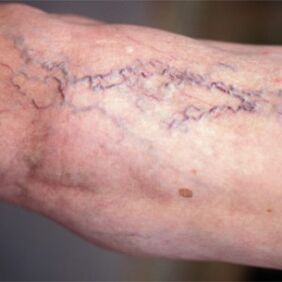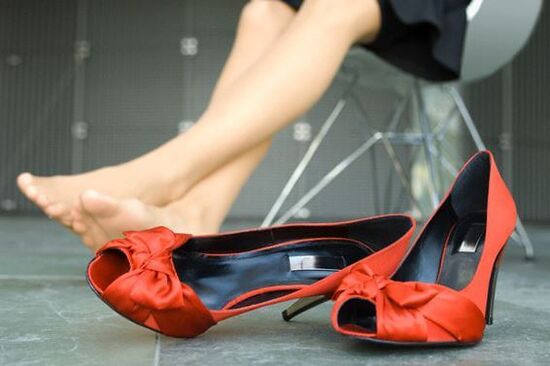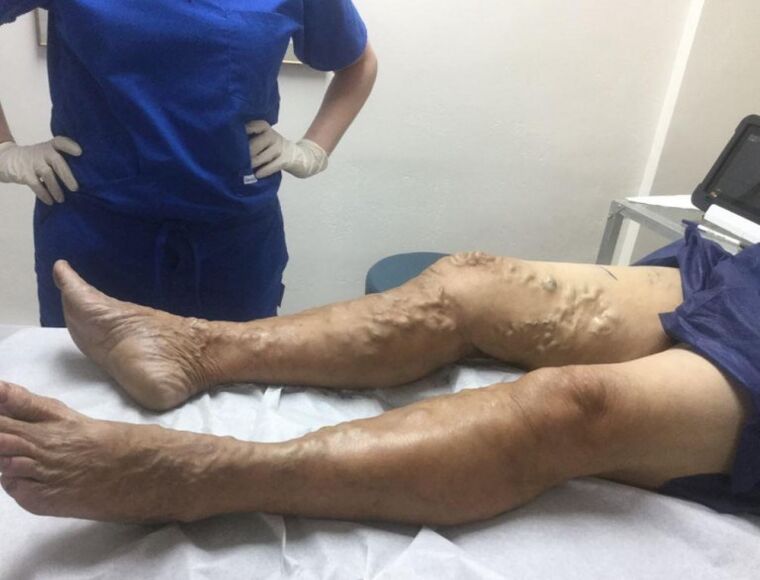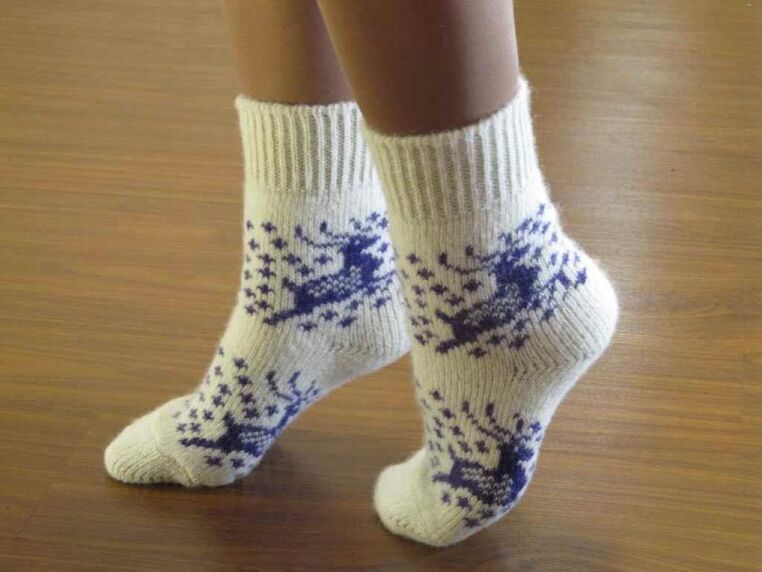Many people suffer from varicose veins over the course of their lives.Unfortunately, this is a fairly common phenomenon that affects not only the legs, as is commonly believed, but also other organs.Fortunately, it is treatable.True, it is lengthy and complex and you should only start it after fully understanding the reasons for its occurrence.
What causes varicose veins, who should worry?
The main symptoms of the onset of the disease:
- the appearance of spider veins or even webs;
- veins became visible;
- the skin on the legs is uncomfortably dry;
- cramps in the leg muscles;
- At the end of the day, leg swelling and heaviness occurred;
- thickening or darkening;
- the veins became tender.

What are varicose veins?This question torments many middle-aged people and others.This term refers to swelling of the veins in the lower extremities.The veins swell, form knots, become very tortuous, and form a lumpy blue surface.
This happens because the blood flow to the veins is not good enough.The blood no longer moves as it should, causing an increase in pressure in the vein.When it exceeds all normal levels, excess blood begins to have a stretching effect on the vein walls.The edges of the vessels move closer to the upper layer of the epidermis and become visible to the naked eye.The first sign of varicose veins is the appearance of vascular networks.Vessels on the legs that are visible through the surface of the skin are diseased.
Varicose veins – what they are has been known since ancient times.Even Byzantine doctors mentioned this disease in their works.The Egyptians fought it with elastic bandages, and Hippocrates, Avicenna and Paracelsus tried to find more effective methods of treatment.
It is very scary that this pathology is very common - about 25 percent of the world's population is susceptible to this disease.Phlebologists say that the main cause of varicose veins is the poor development of connective tissue in the legs.Women most often suffer from this disease, since constant hormonal changes create good conditions for the development of the disease.

PREVENTING CRISIS FRIENDS
Good, strong veins require constant self-care.In the initial stages, varicose veins destroy the beauty of the legs and pose a slight threat to health, but as they progress, they lead to complications and are life-threatening.Varicose veins in other organs are usually associated with various diseases and must be treated together with them in order to achieve a real effect.Risk groups who should first remember about the prevention of varicose veins:
- Anyone who leads a sedentary lifestyle.
- It costs a lot during the day, for example at work.
- Who is overweight or obese?
- Constantly wears high heels or shoes that are too tight.
- Has illness (or recent surgery) in the pelvic area.
- Wears tight clothing that restricts blood flow.
- Often sits cross-legged.
- Pregnant women.
- Athletes who train with regular overloads.
- Takes hormonal medications.
Many people do not even suspect that they are carriers of a serious illness.The advanced stage of this disease is quite difficult to treat, in contrast to the initial stage.Therefore, everyone, and especially those with poor heredity, needs to know what varicose veins are and what symptoms they have, and remember that a timely visit to the phlebologist is as necessary as a preventive examination at the dentist.You have to take care of your health yourself without letting things take their own course.
Varicose veins, what is it?
To understand what varicose veins are, let's look at the underlying causes of this disease.As you know, our body is permeated by a dense network of blood vessels, some of which carry blood to the heart - veins, while others transport it in the opposite direction - arteries.As long as the system is functioning smoothly and the blood vessels are clean, elastic and not exposed to excessive stress, everything is fine.If regular failures occur, sooner or later they can lead to diseases, which include varicose veins.
It can occur on any part of the body, but is most commonly located on the extremities.Partly because the veins withstand high stress when lifting blood through the legs, partly because our limbs are one of the most stressed parts of our body - we are forced to lift weights, walk a lot, stand or sit, which is also bad because it interferes with normal blood flow.
Varicose veins of the extremities: complications
The most common form of this disease, which is essentially what is meant by varicose veins, is varicose veins on the legs.The initial symptoms have been listed above, but what can lead to neglecting treatment?We list the main complications of this disease:
- thrombophlebitis;
- phlebothrombosis;
- trophic ulcers;
- Bleeding from varicose veins.
What is thrombophlebitis?This is an inflammation of the walls of the external veins and the appearance of blood clots on them, which not only restrict blood flow, but can ultimately completely block the vessel.It accompanies varicose veins in the extremities almost from the beginning.And a person who does not take care of his veins, as a result and a number of complications, gets acute thrombophlebitis, when a blood clot not only disrupts blood circulation, but is also the center of inflammation that affects not only the vascular walls, but also surrounding tissues.
Phlebothrombosis– This is the name of deep vein thrombophlebitis, an equally serious and difficult to treat disease in which thrombosis impairs blood flow and the vessels and tissues around them become inflamed.What is a thrombosis?This causes blood clots to form in the vessels, impairing blood flow or even completely blocking the lumen of the blood vessels.Even a partial reduction in the supply of fresh blood slows down tissue metabolism and leads to the accumulation of its products.A complete blockage can ultimately lead to cell death, i.e. tissue necrosis.
The particular danger of these diseases is that it can ultimately lead to a thromboembolism - a blood clot, after it has dissolved, travels through the body in the bloodstream and blocks one of the large arteries, which in turn can be fatal.
Another serious problem, varicose veins in the final stage, are trophic ulcers - open wounds that do not heal in the long term.How long?If the wound does not seem to heal within a month and a half, it is a trophic ulcer.It is treated, but it is a long and complex treatment that requires combining surgical and therapeutic methods.
No less dangerous is a complication such as bleeding from varicose veins.It can be caused either simply by thinning of blood vessels in thickened areas or by mechanical stress.Because it costs nothing to damage a vessel that has become thin and lost its elasticity.Don't think that this only applies to the external veins;those that lie low are also “delicate” and susceptible to any stress, shock or displacement.
Consequences of non-treatment of varicose veins in the photo:

Varicose veins in the video make an even more depressing impression.To prevent this, you need to see a doctor as early as possible and strictly follow all his instructions in both treatment and lifestyle.
Types of varicose veins
As mentioned above, there are other types of varicose veins.There are many of them;These diseases arise for different reasons and while some are quite common, others are a very rare phenomenon that is usually associated with other diseases.
- Reticular varicose veins are a network of blue stars on the thighs and calves.It also occurs in young and thin people and is often considered only a cosmetic defect, although this is the first warning - you need to see a phlebologist.
- Stars and vascular networks on the face are a reason to see an endocrinologist, as they often indicate that a person has problems in the endocrine system.Although the reason may also lie in lifestyle – alcohol abuse, fatty and unhealthy foods, tanning, the habit of squeezing acne.
- Varicose veins of the hands - this problem most often occurs in athletes and those whose work requires constant heavy strain on the hands.
- Varicocele is a varicose vein that surrounds the testicle.It is a very common condition, which is why men, especially teenagers, should seek medical attention at the first symptoms, as an untreated condition often leads to infertility.
- Hemorrhoids are varicose veins of the rectum.It can be caused not only by a sedentary lifestyle but also by heavy lifting, pregnancy, constipation and many other reasons.
- Varicose veins on the legs have several stages and if treatment is not carried out in the initial stages, serious vascular disease and disability can occur.
- Varicose veins of internal organs usually occur as a complication of other diseases or in the postoperative period.These can be varicose veins of the pelvic organs, stomach, esophagus, etc.
This is a short list of the main types of this serious disease.You can find out how you can treat all types of varicose veins in detailed articles on our website.We try to talk regularly about traditional and state-of-the-art treatment methods.
CHRONIC VENOUS INSUFFICIENCY
The cause of this problem is bipedalism, meaning we are the only species on Earth susceptible to it.We will not consider pseudoscientific hypotheses that explain why this happened, although some of them are pretty funny.For example, one assumes that humanity came to Earth from Mars, where gravity is much lower and our bodies are therefore not adapted to earthly stresses, while the other assumes that humans were created by aliens and were underdeveloped somewhere.Be that as it may, when walking upright, the blood vessels have to raise the blood to a considerable height, which puts them under a lot of stress.
Normally, this system works harmoniously, the blood supplies all parts of the body quickly and evenly with oxygen and necessary substances.However, when failure occurs (for example, an injury) or the body is constantly influenced by unfavorable factors (hard work, excess weight, hormonal deficiency, etc.), CVI develops - chronic venous insufficiency.In recent decades, this disease has become noticeably younger and now occurs not only in the older generation, but also in adolescents, which is why everyone should know its symptoms:
- Telangiectasia – dilation of small superficial vessels;
- Swelling of legs, worse in evening;
- cramps, goosebumps and other painful sensations in the calf muscles;
- cold feet;
- pigmentation of the skin of the legs;
- general malaise and tiredness throughout the day.
As you can see, they largely coincide with the symptoms of varicose veins listed at the beginning of the article, since this is the beginning of the same disease - varicose veins.Therefore, if you have at least some of these signs, you need to immediately contact a phlebologist who will prescribe treatment and help you make decisions about your diet and lifestyle.Varicose veins are not a disease that can be cured with pills, but a way of life that must be constantly followed in order not to encounter more serious stages of development.

Modern science offers many treatment methods that compensate for CVI to a certain extent, both eliminating its external manifestations and generally positively affecting the condition of blood vessels.For example, read about spider veins on the legs, their causes and treatment.Medicine today offers a number of measures to combat this “cosmetic” defect, including:
- conservative therapy – ointments and tablets to strengthen the vascular walls and stimulate blood circulation;
- Compression therapy – special medical underwear;
- invasive therapy – microthermocoagulation, microsclerotherapy.
Effective methods that help get rid of telangiectasia and its causes also include therapeutic exercises and lymphatic drainage massage.
Treating varicose veins with complications is much more difficult, but an integrated approach helps here too.What do you mean?This is what modern medicine offers:
- Therapeutic methods – medication, special underwear, massage, physiotherapy.
- Surgical methods (phlebectomy, miniphlebectomy, short stripping, endoscopic vein dissection, etc.).This is the most radical method of treating varicose veins and requires not only preparation for the operation, its professional implementation, but also qualified follow-up.
When treating varicose veins with medication, medications are used both for oral administration - such as drops, tablets and capsules - and for application to the skin - these are various ointments that are used to rub sore legs.Some medications narrow and strengthen blood vessels, others relieve inflammation, and others reduce blood clotting, so they should only be used as prescribed by a doctor.External active ingredients, i.e. various creams, ointments and jellies, usually have pain-relieving, anti-inflammatory and fever-reducing properties.Components that affect blood clotting are often added to them.These drugs act mainly on superficial vessels, but have fewer contraindications.
If chronic venous insufficiency is detected, it is necessary to exclude the causes of venous disease.That is, change a job that requires you to stand on your feet all day or lift weights, lose weight, give up spicy food, etc. It is clear that, for example, you cannot get rid of a hereditary predisposition, but knowing about it, you can choose a suitable profession and monitor the condition of your veins, including visiting a phlebologist once a year for prevention.Despite all the advances in medicine, our health is still in our hands.

























